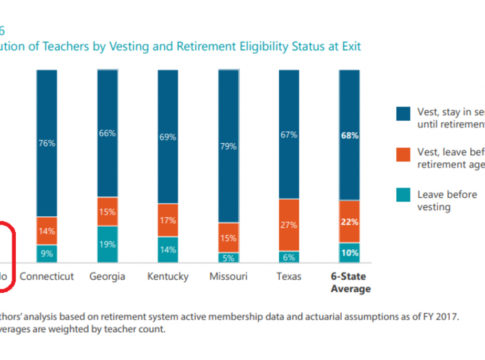If you care about teacher pay or teacher retention or, heaven forbid, teacher retirement, you should read Fordham’s new report, (No) Money in the Bank. Author Marty Lueken analyzed how long it takes teachers in the largest public school districts in the country to qualify for retirement benefits worth at least as much as their own contributions—a threshold known as the “crossover point.”
 At first blush, this may seem like a low bar, but the results may surprise you. In the median city, teachers must stay for twenty-five years just to reach this minimum level of retirement savings.
At first blush, this may seem like a low bar, but the results may surprise you. In the median city, teachers must stay for twenty-five years just to reach this minimum level of retirement savings.
To be clear, this is different from how retirement benefits accrue for most workers in defined contribution (DC) retirement plans like 401(k) or 403(b) plans, where workers are immediately entitled to their own contributions and interest. In those plans, there is no crossover point because a worker’s retirement account begins growing immediately and she never has to suffer long periods with negative savings rates.
Teachers are different. In fact, teachers have the most back-loaded retirement plans of any set of workers—meaning teachers have to wait longer to reach their crossover point than any other profession.
Consider that:
• K–12 teachers are the most likely group of workers to be enrolled in defined benefit (DB) retirement plans, even among other state and local government workers. DB plans deliver benefits through formulas determined by a worker’s salary and years of experience, but those benefits tend to be back-loaded until just before the worker reaches the plan’s normal retirement age.
• Public pension plans are not covered by the federal law governing private-sector retirement plans (called ERISA). As such, states can and do impose longer vesting periods than are required in the private sector. As of 2014, fifteen states required teachers to serve ten years before qualifying for any retirement savings, much longer than what’s allowed in the private sector.
• Even after qualifying for some benefit, the DB plans offered to teachers are more back-loaded than those offered to other public-sector workers. (See Figure 2 here.)
• Finally, about 40 percent of teachers do not participate in Social Security, meaning they are especially vulnerable to poorly designed state-run retirement plans. That’s a lower participation rate even among other public-sector workers, and it stands in contrast to all private-sector employees, who are covered.
Lueken’s report presents some staggering data on a city-by-city basis, but it also presents paths forward. In six of the fifty-one cities in the study—Anchorage, AK; Miami, FL; Detroit, MI; Columbus, OH; Greenville County, SC; and Alpine, UT—teachers can join DC plans that offer positive retirement benefits from day one on the job. Another six cities offer teachers hybrid retirement plans that combine traditional DB plans with a DC component. In those hybrid plans, the median crossover point is ten years. That’s still a long commitment to require of a teacher, but it’s better than the twenty-seven years or more required in the districts that only offered a DB plan.
Despite my best efforts, this reality has still not fully penetrated into the public consciousness. Part of the problem is that the public and the media tend to focus on the small portion of teachers who remain for twenty-five, thirty, or thirty-five years and therefore do qualify for substantial benefits. Those “pension winners” make for good stories, but that’s not the majority of teachers.
The more accurate story to tell is that public school teachers are enrolled in horribly back-loaded retirement plans. Most teachers won’t be served well by that arrangement. Based on the data above, and without even mentioning their funding problems, I think it’s time to acknowledge that public school teachers have some of the worst retirement plans of any group of workers in the entire country. Until we begin to acknowledge that reality, we won’t see any real changes.
— Chad Aldeman
Chad Aldeman is a principal at Bellwether Education Partners
This post originally appeared in Flypaper.




